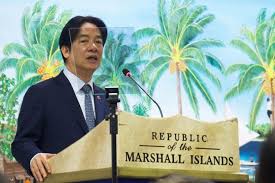by Martin Haffner Associate Editor
Title: Marshall Islands Establishes First Marine Sanctuary to Protect Pristine Pacific Corals
Majuro, Marshall Islands – In a historic move to safeguard its vibrant marine ecosystems, the Republic of the Marshall Islands has officially designated its first marine sanctuary, a landmark decision that aims to protect the region’s “pristine” coral reef systems from environmental degradation and climate change.
The sanctuary, which encompasses over 650,000 square kilometers of ocean, is one of the largest marine reserves in the world, representing a significant commitment by the Pacific Island nation to preserve its unique biodiversity. The announcement was made at a ceremony attended by government officials, environmental activists, and representatives from international conservation organizations.
Marshall Islands President David Kabua expressed his enthusiasm for the initiative, stating, “Today, we take a monumental step towards preserving our natural heritage for future generations. Our coral reefs are not only a crucial part of our culture but also essential for our economy and the wellbeing of our people.”
The marine sanctuary is home to a diverse array of marine life, including endangered species such as the hawksbill turtle and the Napoleon wrasse. As global warming and ocean acidification pose increasing threats to coral ecosystems, the new sanctuary aims to provide a refuge for these delicate habitats, mitigating the adverse effects of climate change.
Environmentalists have praised the Marshall Islands for its proactive approach to marine conservation. “This sanctuary is a beacon of hope for coral reefs worldwide,” said Dr. Mira Banfield, a marine biologist with the Global Coral Watch Initiative. “By acting now to protect these ecosystems, the Marshall Islands is setting a precedent for other nations to follow.”
The establishment of the sanctuary also comes at a time when the Marshall Islands is actively seeking to raise awareness about the impacts of climate change. With rising sea levels threatening the low-lying atolls, the government has voiced concerns about the need for global action to address the climate crisis. The sanctuary is seen as a vital step in both climate resilience and biodiversity conservation.
Local fishing communities have been involved in discussions about the sanctuary since its conceptualization, and the government aims to ensure that traditional fishing rights are preserved while implementing sustainable practices. “It’s important that we balance conservation with the livelihoods of our people,” President Kabua noted.
International partners, including the United Nations and various NGOs, have pledged support for the sanctuary’s management and monitoring. Educational programs and research initiatives are also planned to increase public awareness regarding the significance of marine conservation.
As the Marshall Islands steps boldly into a new era of environmental stewardship, leaders hope that this marine sanctuary will inspire similar initiatives across the Pacific and beyond. “We are all guardians of our oceans. The future of our planet depends on our actions today,” President Kabua concluded.
With this move, the Marshall Islands not only protects its own invaluable natural resources but also contributes to the global mission of preserving the world’s oceans for the generations to come.


